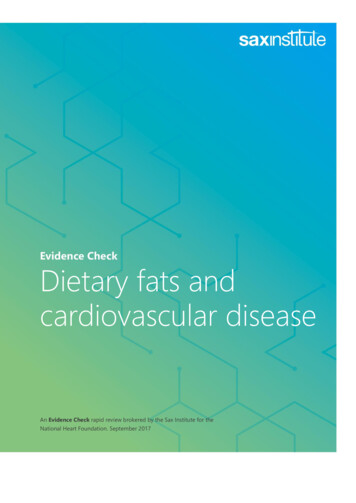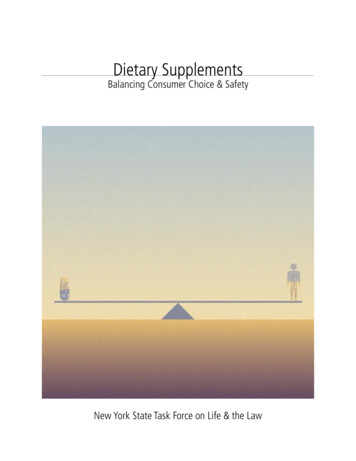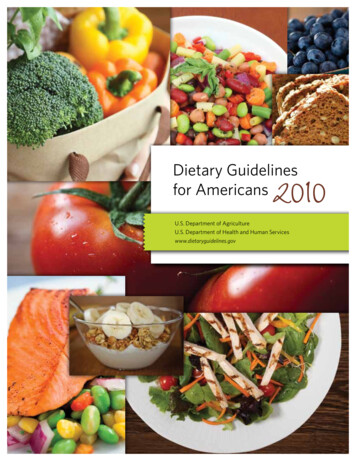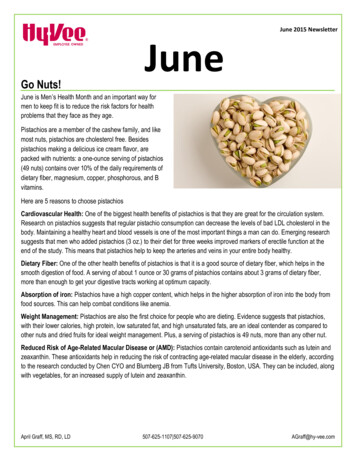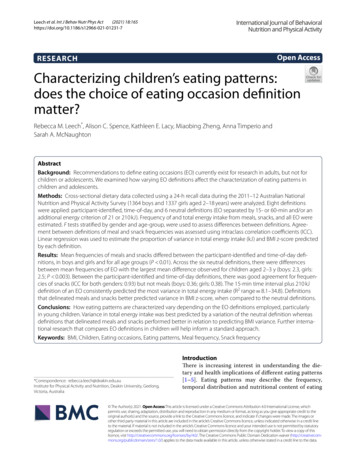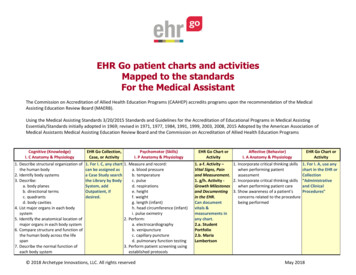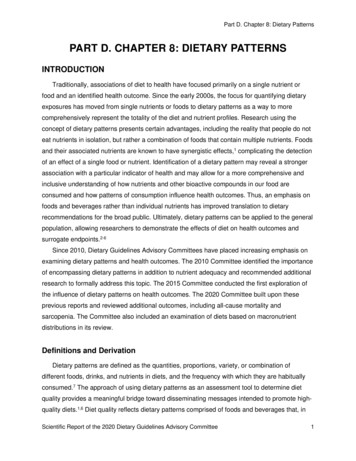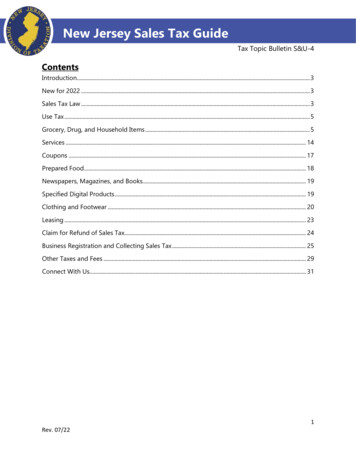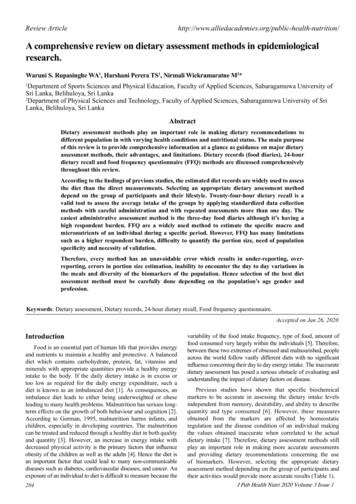
Transcription
Review h-nutrition/A comprehensive review on dietary assessment methods in epidemiologicalresearch.Waruni S. Rupasinghe WA1, Harshani Perera TS1, Nirmali Wickramaratne M2*Department of Sports Sciences and Physical Education, Faculty of Applied Sciences, Sabaragamuwa University ofSri Lanka, Belihuloya, Sri Lanka2Department of Physical Sciences and Technology, Faculty of Applied Sciences, Sabaragamuwa University of SriLanka, Belihuloya, Sri Lanka1AbstractDietary assessment methods play an important role in making dietary recommendations todifferent population in with varying health conditions and nutritional status. The main purposeof this review is to provide comprehensive information at a glance as guidance on major dietaryassessment methods, their advantages, and limitations. Dietary records (food diaries), 24-hourdietary recall and food frequency questionnaire (FFQ) methods are discussed comprehensivelythroughout this review.According to the findings of previous studies, the estimated diet records are widely used to assessthe diet than the direct measurements. Selecting an appropriate dietary assessment methoddepend on the group of participants and their lifestyle. Twenty-four-hour dietary recall is avalid tool to assess the average intake of the groups by applying standardized data collectionmethods with careful administration and with repeated assessments more than one day. Theeasiest administrative assessment method is the three-day food diaries although it’s having ahigh respondent burden. FFQ are a widely used method to estimate the specific macro andmicronutrients of an individual during a specific period. However, FFQ has many limitationssuch as a higher respondent burden, difficulty to quantify the portion size, need of populationspecificity and necessity of validation.Therefore, every method has an unavoidable error which results in under-reporting, overreporting, errors in portion size estimation, inability to encounter the day to day variations inthe meals and diversity of the biomarkers of the population. Hence selection of the best dietassessment method must be carefully done depending on the population’s age gender andprofession.Keywords: Dietary assessment, Dietary records, 24-hour dietary recall, Food frequency questionnaire.Accepted on Jan 26, 2020IntroductionFood is an essential part of human life that provides energyand nutrients to maintain a healthy and protective. A balanceddiet which contains carbohydrate, protein, fat, vitamins andminerals with appropriate quantities provide a healthy energyintake to the body. If the daily dietary intake is in excess ortoo low as required for the daily energy expenditure, such adiet is known as an imbalanced diet [1]. As consequences, animbalance diet leads to either being underweighted or obeseleading to many health problems. Malnutrition has serious longterm effects on the growth of both behaviour and cognition [2].According to Gorman, 1995, malnutrition harms infants, andchildren, especially in developing countries. The malnutritioncan be treated and reduced through a healthy diet in both qualityand quantity [3]. However, an increase in energy intake withdecreased physical activity is the primary factors that influenceobesity of the children as well as the adults [4]. Hence the diet isan important factor that could lead to many non-communicablediseases such as diabetes, cardiovascular diseases, and cancer. Anexposure of an individual to diet is difficult to measure because the204variability of the food intake frequency, type of food, amount offood consumed very largely within the individuals [5]. Therefore,between these two extremes of obsessed and malnourished, peopleacross the world follow vastly different diets with no significantinfluence concerning their day to day energy intake. The inaccuratedietary assessment has posed a serious obstacle of evaluating andunderstanding the impact of dietary factors on disease.Previous studies have shown that specific biochemicalmarkers to be accurate in assessing the dietary intake levelsindependent from memory, desirability, and ability to describequantity and type consumed [6]. However, these measuresobtained from the markers are affected by homeostaticregulation and the disease condition of an individual makingthe values obtained inaccurate when correlated to the actualdietary intake [7]. Therefore, dietary assessment methods stillplay an important role in making more accurate assessmentsand providing dietary recommendations concerning the useof biomarkers. However, selecting the appropriate dietaryassessment method depending on the group of participants andtheir activities would provide more accurate results (Table 1).J Pub Health Nutri 2020 Volume 3 Issue 1
Citation: Waruni S. Rupasinghe WA, Harshani Perera TS, Nirmali Wickramaratne M. A comprehensive review on dietary assessment methods inepidemiological research. J Pub Health Nutri. 2020; 3(1):204-211.Dietary assessment involves reviewing the intake offood and individual dietary component and comparing theamount consumed with the reference values to evaluate ifany deficiency or excess is likely to occur [8]. Therefore, tomaximize the accuracy in weighing of all food consumed andanalysing its chemical compositions is involved. Biochemistryplays a significant role in establishing how the body usesvarious nutrients and has also been important in defining certaindeficiency states [9]. However, analysing each componentin an individual diet biochemically is impractical for clinicalpurpose. Therefore, several dietary assessment methods such asDiet records or food diaries, Dietary recalls and Food frequencyquestionnaires (FFQ) are frequently used. These methods differfrom each other concerning the time duration utilized to collectdietary intake information and in the methods used to quantifythe portion size. Use of food diaries is also a common methodespecially 3-day food diaries and 7-day food diaries in whichweighted or estimated food records are used. Food frequencyquestionnaires (FFQ) are also used as an essential and commonlyused tool to obtain information. However various versionsof FFQ are developed since these questioners are greatlyinfluenced by culture and language. Measuring dietary intakeaccurately is crucial to understand the role of diet in causingand preventing several non-communicable diseases such ascancer, heart disease, and diabetes. The WHO recommendsa healthy diet and regular physical activities in preventingand controlling the above diseases [10,11]. Hence providingproper recommendations to people are important facilitatingthem to follow a healthy dietary pattern that would improvehealth conditions and reduce disease risks. Therefore, gatheringinformation using a suitable assessment method is important asthe accuracy of the information gathered would vary with thelifestyle of the individual and with the assessment method used.Through this review, we compare and discuss three dietaryassessment methods Food diaries, 24-hour dietary recall methodand FFQ which are commonly used for evaluating dietary intakethroughout the world.Diet Records/Food DiaryIn a food diary or diet record, the person records all the foodand beverages consumed, including ingredients, preparationmethod, and quantity of the food consumed at a given period.This method provides all the instruction and description areprovided for the individual before assigning the task to recordthe diet which ensures the accuracy and reliability of theinformation provided. According to the time, there are "Threeday food diaries" (records two weekdays and one weekend day)and "Seven-day food dairies" to estimate the nutrient intake. Themost common methods for portion size are estimated dietaryrecord, weighed diet record, and duplicate portion as it is directand feasibility is high.However, the food diaries highly depend on the memoryrecall and as the study period lengthens, participant compliancedecrease making this method disadvantages with the aboveissues. According to Magkos &Yannakoulia, 2003, this methodis also disadvantaged for being relatively expensive and timeconsuming [12]. However, with the follow-up interviews, theaccuracy could be increased.J Pub Health Nutri 2020 Volume 3 Issue 1In weighted diet- record individual weighs the items on ascale before and after consumption. The Weighted dietaryrecords are a widely used method where precise portionsize of consumed food is measured. This method too has itsdisadvantages such as high respondent burden, miss-reporting,expensive and provides only limited data on food composition.Through weighted dietary records are more accurate thanestimated dietary records, the former is not suitable for theathlete because they lack time for measuring each item with thebusy schedules and patience [12].Therefore, many researchers use duplicate sample methodsto measure the selected nutrients intake than for total energyintake [13-15]. Stephany & Schuller, 1980 used the duplicatesample method to evaluate the nitrate, nitrite and volatileN-nitrosamines intake from foods and drinks within 24-hoursampling period and varied and precise data revealing thatthe mean daily intake of nitrate and N-nitrosodimethylaminewas 179 mg and 0.38 μg respectively and the major source ofnitrosamine from the intake of beer (71%) [15].Evaluation of duplicate portions of 24-hour diets also allowedto analyzed aluminum, cadmium, copper, lead, manganese,mercury, zinc, nitrate, nitrite and volatile N-nitrosamines intakein 110 adults and provides precise data revealed the daily intakeof copper (1.2 mg) was only 50% of recommended values,while manganese (3.3 mg) and zinc (8.4 mg) was adequate andmarginal to recommended amounts [14].Bro et al., successfully used a 48 h duplicate food portionsmethod to measure average daily intakes of essential and toxictrace elements consumed through diets among 100 men of agesranging 30-34 years from both urban and rural areas [13]. Hencethe duplicate portion method is recommended for the analysis ofselected components in the dietary intake [13-15].An epidemiological assessment of diet which was performedwith the comparison of seven-day diary with food frequencyquestionnaire using urinary markers of nitrogen, potassiumand sodium where 179 individuals completed seven day diaryand FFQ in two occasions separated in 12 months durationand provide urine sample one six times in 6-9 months durationrevealed that the seven-day diary was the better estimateof average intake than FFQ [16]. In contrast Livingstone etal. revealed that seven-day weighted dietary records tendto underestimate and the diet histories are biased towardsoverestimation in food intake [17]. However, three to four dayestimated diet record is the most widely used approach andsingle or multiple dietary recall method is the most commonmethod used for measuring the energy intake of athlete [18].Estimation diet record is the most widely used methodthan any other food records since it exerts lower respondentburden with the comparison to other food diaries. However,misreporting and low accuracy was observed in comparison toweighed diet records as they estimate the portion size [19].Gustafsson & Sidenvall, 2002 used a three-day food diaryto study about food-related health perceptions and food habitsamong older women in age 64 to 88 years who living aloneor cohabiting and independently manage shopping and cookingin central Sweden. The results revealed that cohabiting women205
Rupasinghe/Perera/Wickramaratne.had proper meals (1872 627 kcal) than women who livingalone (1350 443 kcal) [20].Evaluating the reproducibility of a three day dietary recordused for a study of 26 adults and 35 children of both sex whocompleted two records with the 7 day interval stated thatchildren reported more stable intake (9478 2566 KJ, 9234 2552 KJ, Interclass Correlation 0.86, P 0.01) than adults(9740 2713 KJ, 8919 1988 KJ, Interclass Correlation 0.72,P 0.01) indicating the adults tend to alter the records whendocumenting the diary [21].A study of randomized controlled trial of primary schoolbased intervention to reduce risk factors for obesity based on634 children aged 7-11 years in 10 primary schools revealedthat the consumption of high sugar foods was higher (Weightedmean difference 0.8, 0.1-1.6, CI 95%) in overweight childrenin intervention group than control group. However, the 24hour recall and three-day diary methods which used in thisstudy did not provide accurate data to be assessed [22]. Hencethe researchers found that performing an accurate dietaryassessment was difficult in children.24-hour Dietary RecallTwenty-four-hour dietary recall method describes food andbeverages in detailed that an individual consumed in the past 24hours. The interview is conducted in two ways of "starting torecall from the beginning of the recalling day" or "starting withthe current day and works backward" and in general requiresapproximately 15 to 20 minutes by depending on the typesand variety of the food that is consumed [23]. According toThompson & Byers, 1994 a standard diet recall would usuallyrequire an interview of at least 20 minutes [24].The 24-hour dietary recall method is suitable for large scalesurveys [25] which has the lower respondent burden [12] andcould be administered as a face to face interview or telephoneinterview. A 24-hour dietary recall method is advantages as it isto administer and fast completion with the major disadvantagebeing the needs of an experienced interviewer [12]. The errorsof measurement are small when the interviewers are well trainedand provided with written protocols. Therefore, this tool isconsidered to be an accurate and well-established method [26].The validity of the 24-hour recall method was tested withthe comparison of recalled and observed food nutrient intakeof 140 individuals (84 of males & 56 females) 15 to 57 years.The results revealed that -6% & 11% of the difference of meanrecalled and observed nutrient intake can be seen, except insucrose (-20%) and vitamin C(-16%). The accuracy of women'srecall was higher than males and the age group 35 to 44 yearsprovides more valid data in comparison to others. Hence thevalidity of the 24-hour dietary intake method was satisfactory ingroup-level while it was unsatisfactory in individual level [25].The validity of the self-reported food items about thetime interval between eating and reporting of the children infourth grades (age between 9 to 10 years) was tested with thecomparison of recalled and observed food items. The resultsrevealed that the accuracy of recalled was decreased with thetime interval between eating and reporting was increased. Thefood items reported but not observed was increased 5% to 13%206and food items reported but observed was increased 6% to 32%from same day to following morning respectively [27]. Frank etal., proposed an improved 24-hour recall method by includingthe careful observation of school lunch operation, graduatedfood models, and standardized probing to increase the reliabilityof the collected data by school children [26].Personality characteristics such as body image, adiposityand relative weight of the adults in have shown to be affectingthe records of the 24-hour dietary recall method. Hencethe body image and fatness are key features considered aspredictors of underreporting of energy intake on 24-hour dietaryrecall interviews [28]. In a study of 98 individuals with a 24-hourdietary recall for the energy intake, doubly labeled water for energyexpenditure and Physical and psychological characteristics alsorevealed that the people who dissatisfied with their body imageunderreported a 398 kcal/ day. Gender also affected the reportingconcerning the body fat percentage where the women underreportedrelative body weight 21 kcal/day/kg as compared to that of 16kcal/day/percent body fat of men [28].Dietary intake of the children in home setting measured byinterviewing parents with 24-hour dietary recall method founddifficulties in estimating actual portion sizes eaten. Hence theaccuracy of the recalls was poor in both under-reporting andover-reporting. But many studies that used the 24-hour recallmethod to estimate dietary intake of children was found thatparents were well-educated [29]. The other disadvantage of thismethod is the inability of the parents to recall the food intakewhen children are out of the home especially when in preschool.Estimation of portion sizes and memory dependent aretwo limitations of the 24-hour dietary recall method andalso it needed a well-trained interviewer to obtain accuratemeasurements. The improved version of the 24-hour recall ismultiple-pass 24-hour dietary recall method which includedthree passes to get information from the participants. The passestermed as the quick list of food items, the detailed descriptionof food and beverage items consumed and the review of usingfood models. The accuracy of the multiple-pass 24-hour dietaryrecall method was tested by estimating the energy expendituremeasured using the doubly labeled water method of 24 childrenin the age between 4 to 7 years. The results revealed thatmultiple-pass 24-hour dietary recall method gives a preciseestimation of dietary intake of the children as there was not anysignificant correlation between individual measures of energyintake and expenditure (r 0.25, P 0.24) [30]. Multiple-pass 24hour dietary recall method was suitable for large scale surveysand could be administered by telephone. In a study of 78individuals age ranging from 22 to 67 years tested the accuracyof the multiple-pass 24-hour dietary recall method in randomlyselected days on a self-selected diet (all meals were preparedtheir meals) and controlled diet period (meals were providedby the study). The results revealed that both men and womenunderestimated energy intake by 11% and 13%, respectively inself-selected diet period while men underestimation increased in13% whereas women overestimated the energy intake by 1.3%in controlled diet period. The recalled energy intake measuredwith the multiple-pass 24-hours dietary recall the women wereinfluenced by the situation and men underestimate the energyintake regardless of the circumstance [31].J Pub Health Nutri 2020 Volume 3 Issue 1
Citation: Waruni S. Rupasinghe WA, Harshani Perera TS, Nirmali Wickramaratne M. A comprehensive review on dietary assessment methods inepidemiological research. J Pub Health Nutri. 2020; 3(1):204-211.Table 1. Dietary Assessment methods in epidemiological studies.MethodThree-day fooddairiesSeven-day fooddairiesDescriptionCollection of diet recordby Self-administereddairy, provided withall instructions anddescriptionsWeighted dietrecordDuplicate dietmethodCollection of duplicate dietsample and direct analysisFood frequencyquestionnairesAdvantagesWomen 64-88 yearsTremblay et al.,198326 adults & 35childrenPosner et al., 199273 females and 77malesSahota et al., 2001634 children aged 7-11 yearsDay et al., 2001179 individualsHoidrup et al.,2002175 men and 173women aged 30-60yearsMahalko, et al.198518 men 36 femaleaged 55 -99 yearsBingham et. al.,1994160 women aged 50-65 yearsLivingstone et al.,199241 male & 37 femaleaged 3-18 yearsStephany &Schuller, 1980141 men and 60womenEllen et al., 1990,110 adultsBro et al., 1990.100 men 30-34 yearsCollection of diet record bySelf-administered dairyCollection of diet recordby weighing food on thescale and recorded byparticipants24-hour DietaryrecallStudy, Year, SampleGustafsson &Sidenvall, 2002Schoeller, 1995-Karvetti & Knuts,1985140 individuals 15 to57 yearsDisadvantages Lower respondent burden thanother food dairies Depend on memory recall Good for the studies about food Adults tend to alter the recordsrelated health perception & habits Difficult to take accurate data Could Self-administeredfrom children Essay to administered Literacy affect for the completion Fast completion than other foodof the recorddairies High respondent burden Depend on memory recall Participant compliance decrease Better estimation on average food Literacy affect for the completionintakeof the record Could Self-administered Time-consuming Cannot use for long term dietarystatus of group of people Mis-reporting Gives precise portion size Could Self-administered High respondent burden Mis-reporting Limited data on food composition Not suitable for athlete Expensive Time-consuming Good to measure selectednutrients Gives precise data on foodcomposition High respondent burden Expensive Time-consuming Suitable to measure dietary intake Need an experienced interviewerof athlete Highly depend on memory Suitable for large scale survey Should equipped with well written Lower respondent burdenprotocols and food modelsBingham et. al.,160 women aged 50Subjective measure using Could be administered through Less validity in individual level1994-65 yearsopen-ended questionnairestelephone Personality characteristicsBriefel et al., 199514801 individualsadministered by a trained Fast completionand gender affect for the misDeBiasse et al.,interviewer Great validity in group level surveysreporting36 participants2018 Reliability increase with the use of Not suitable for childrenfood models, standardized probing Recalling from parents not73 females and 77 Good assessment for lowsuitable for the children not inPosner et al., 1992malessocioeconomic status womenhome settingBingham et. al.,160 women aged 50 Highly memory dependent1994-65 years Ability to self-administered Difficult to quantify the portionUsed to estimate specific Inexpensivesize173 womenmacro and micronutrients in Willett et al., 1985 Suitable for large scale survey Higher mis-reportinga specific period on time (1 Mullen et al., 1984 31 college students Suitable for food consumed in large Higher respondent burden withday to several months)quantitiesthe rises of food listDay et al., 2001179 individuals Good assessment for low Need of population specificitySubjective measure usingsocioeconomic status women Not suitable for the accessorya predefined, self- or Could use for the rankingfoodsDeBiasse et al.,interviewer-administered36 participantsindividuals according to the usual Necessity of validation2018formatintake Not precise estimation for usualfood intake & not informativeFood Frequency QuestionnairesFood frequency questionnaires are used to estimate thespecific macro and micronutrient of an individual consumesduring a specific period on time usually one day to severalmonths. FFQs are largely depended on the individual's abilityto memorize and quantifying the particular food or food groupconsumed. Hence it increases the burden of respondents withthe rises of the food list, difficult to quantify the portion sizes,need of population specificity and necessity of validationto use are some disadvantages [12]. However, the ability toself-administered, inexpensiveness, suitability for large scalesurveys, could be self-completed by the respondents and couldpost to the respondents are the advantages in FFQs.To evaluate the reproducibility and validity of a 61-itemSemi-quantitative FFQ Willett et al., used the dietary intakerecords collected four times in one year period by 7-dayweighted food diary and FFQ records twice in one year periodJ Pub Health Nutri 2020 Volume 3 Issue 1among 173 women [32]. The results revealed that the differencebetween the methods of diet records, FFQ 1 & FFQ 2 wasgenerally small (1620 kcal /- 323 kcal, 1418 kcal /- 496 kcaland 13711 kcal /- 482 kcal respectively). According to Willettet al., simple self-administrated dietary questionnaire was auseful measure to evaluate usual nutrient intake over a periodof one year [32].A food-based validation of a dietary questionnaire by Salviniet al., used weighted dietary records and self-administered foodfrequency questionnaire to evaluate reproducibility and validityof responses for 55 specific foods and beverages and foundthat foods that often considered as healthy such as fruits andvegetables were over-reported while less desirable foods wereunderestimated by FFQ [33].Mullen et al., tested the validity of FFQ among 31 collegestudents who lived and dinned in a dormitory and used 278common food components in United State [34]. The results207
Rupasinghe/Perera/Wickramaratne.revealed that the foods considered as major components of ameal had greater accuracy than accessory foods which usedin small quantities like nuts or seeds while actual intake ofall individuals was significant (r 0.66, P 0.002). Howeveraccording to Mullen et al., food frequency technique used forthis study could not be recommended as a precise estimationmethod for the usual intake of general individuals becauseof the unrepresentativeness of the general populations [34].Furthermore, an assessment of diet which compared 7-day fooddiary with food frequency questionnaire using urinary markersfound that the correlation between errors in different nutrientswas higher in FFQ (0.77-0.80) than for the 7-day food diary(0.52-0.70) [16].Comparison of Dietary Intake MethodsRecords of dietary assessment methods are verified withthe reference methods like total energy expenditure, restingmetabolic rate and physical activity, doubly-labeled water, andtotal water loss. The doubly-labeled water method which widelyused to validate the measurement of total energy expenditure infree-living subjects also serves as a reference for validating theaccuracy of self-reported energy intake [35].The habitual energy intake tends to be underestimated bythe self-reported dietary intake records methods than the actualenergy expenditure because of the increase of underreporting[35]. Hence none of the self-reported intake instrumentsdemonstrates greater accuracy against doubly-labeled watermethod. According to Trabulsi & Schoeller, 2001, the physicaland psychological characteristics of the study participantssignificantly affect for the underreporting of the energy intake[36].Feasibility of the 24-hour dietary recall method and selfadministrated FFQ was tested with 24-hour recalls conductedby two interviewers and a 110-item FFQ with use of 36participants [37]. Feasibility was determined by the contactsand retentions of the methods and acceptability of the responsesto open- and closed-ended questions. Dietary assessments withthe 24-hour dietary recall and FFQ were acceptable among lowsocioeconomic status women with 89% and 91% responsesrespectively [37].The comparison of three nutritional intake estimationmethods of 24-hour recall, 3-day food record and foodfrequency questionnaire by Posner et al., used 73 females and 77males from Framingham in the United States [38]. The resultsrevealed that 24-hour recall and 3-day records were similar inboth women (1646.1 /- 823.5 kcal and 1625.7 /- 483.2 kcal)and men (2228.2 /- 767.8 kcal and 2273.6 /- 723.1 kcal).Mean intake calculated from FFQ of women was higher (1782.5 /- 586.7 kcal) while men's intake was lower (2035.1 /- 635.3kcal) respect to the other two methods. According to the results,FFQ is usable for the ranking individual according to the usualintake but not informative compared to the other two methodsof 24-hour recall and 3-day records.The dietary calcium intake in postmenopausal MalaysianWomen compared with the three-day food records and FFQwith 230 Chinese postmenopausal women aged 50- 65 yearsin Kala Lumpur by Chee et al., [39]. The results revealed thatthere was no significant difference between dietary records and208FFQ record (447.4 168 mg/day and 498.7 211 mg/day,0.563(P 0.001)). According to the results obtained FFQ wasfound mostly to overestimate the calcium intakes than 3-dayfood diary method.A comparison of dietary histories and seven day foodrecords in a nutritional assessment of older adults by Mahalkoet al., found that there was a significant difference for energyconsumption (1634 477 Kcal, 1745 455 Kcal, P 0.06), fat(65 29 g, 74 26 g, P 0.01), saturated fatty acids (25 11g, 27 10 g, P 0.01), Oleate (23 11 g, 27 10 g, P 0.01),Linoleate (10 6 g, 11 5 g, P 0.05), cholesterol (260 101 mg, 315 118 g, P 0.01), ascorbic acid (106 50 mg,90 37 mg, P 0.01) and Potassium (2.8 0.7 g, 2.6 0.7g, P 0.05) between dietary histories and 7-day food records[40]. According to the results, both methods are not preciselyequivalent and not a useful measure of the long-term dietarystatus of a group of people. Nutritional components like vitaminA and cholesterol which having day to day variations did notprovide representative intake and difficult to determine the usualintake by these methods. Based on the findings of Mahalko etal., neither dietary histories nor 7-day food records was superiorto each other [40].An assessment of habitual energy and macronutrient intakein adults by Høidrup et al., used comparison of a 7-day foodrecord with dietary history interview with 175 men and 173women aged 30-60 years in Denmark. The results found thatmacronutrients and energy intake was slightly higher in the7-day food records (7.4 MJ for women, 10.5 MJ for men) thandiet history interview (7.1 MJ for women and 10.4 MJ for men).Although total energy intake was stable over the range of ageand BMI was underestimated by approximately 20% comparedto the estimated energy expenditure in both diet methods [41].Drawbacks in Dietary MethodsWhen selecting a dietary assessment method, the attentionshould be provided to the validity, reliability, reproducibility,specificity, sensitivity, quantifiably and variability within andbetween the individuals and minimize the errors like systemicerrors, random errors and measurement errors. Accordingto Westerterp & Goris, there is no method for the accuratedetermination of dietary intake [42].Dietary intake methods that under or overestimate the dietlead to biased estimation and do not provide valid data. The
A comprehensive review on dietary assessment methods in In weighted diet- record individual weighs the items on a scale before and after consumption. The Weighted dietary records are a widely used method where precise portion size of consumed food is measured. This method too has its disadvantages such as high respondent burden, miss-reporting,
